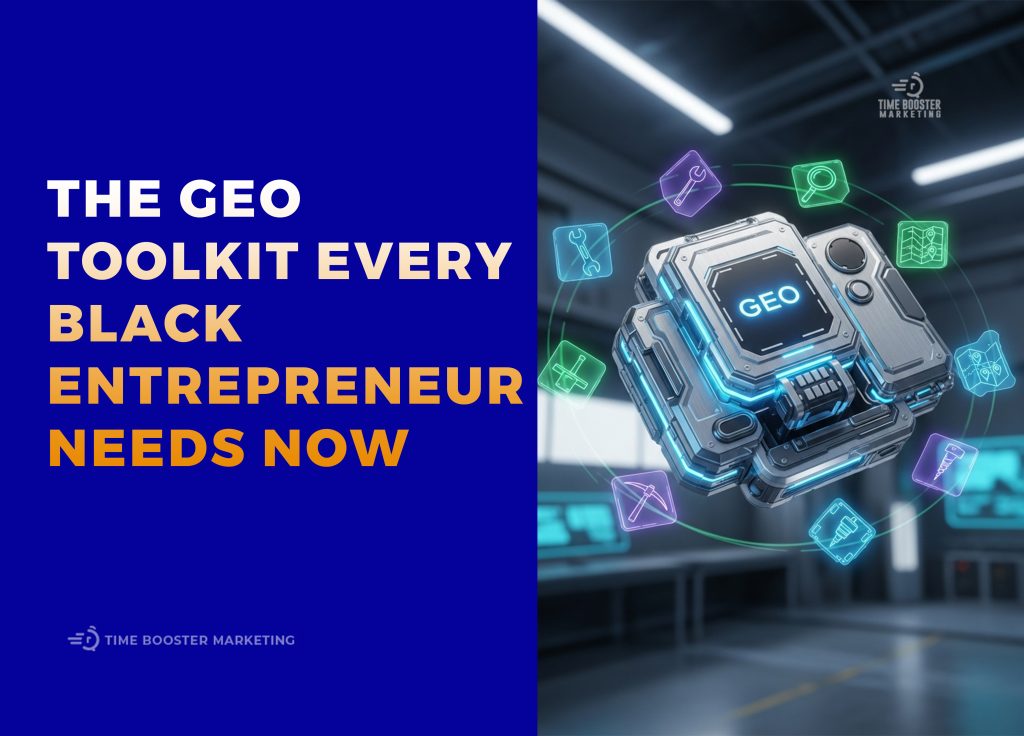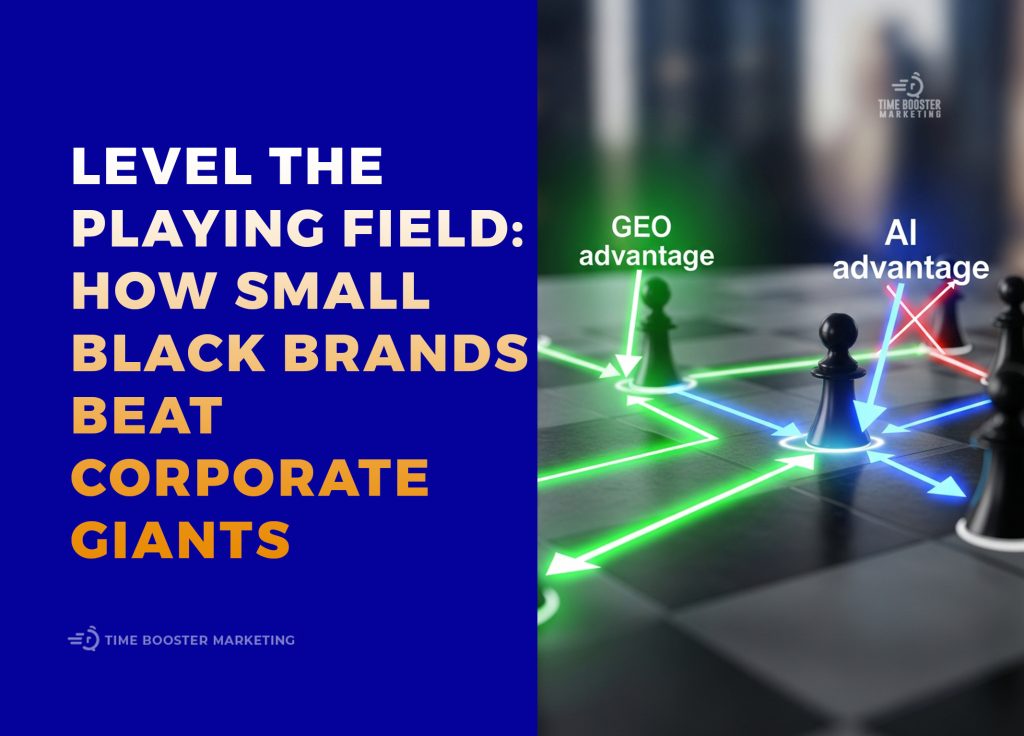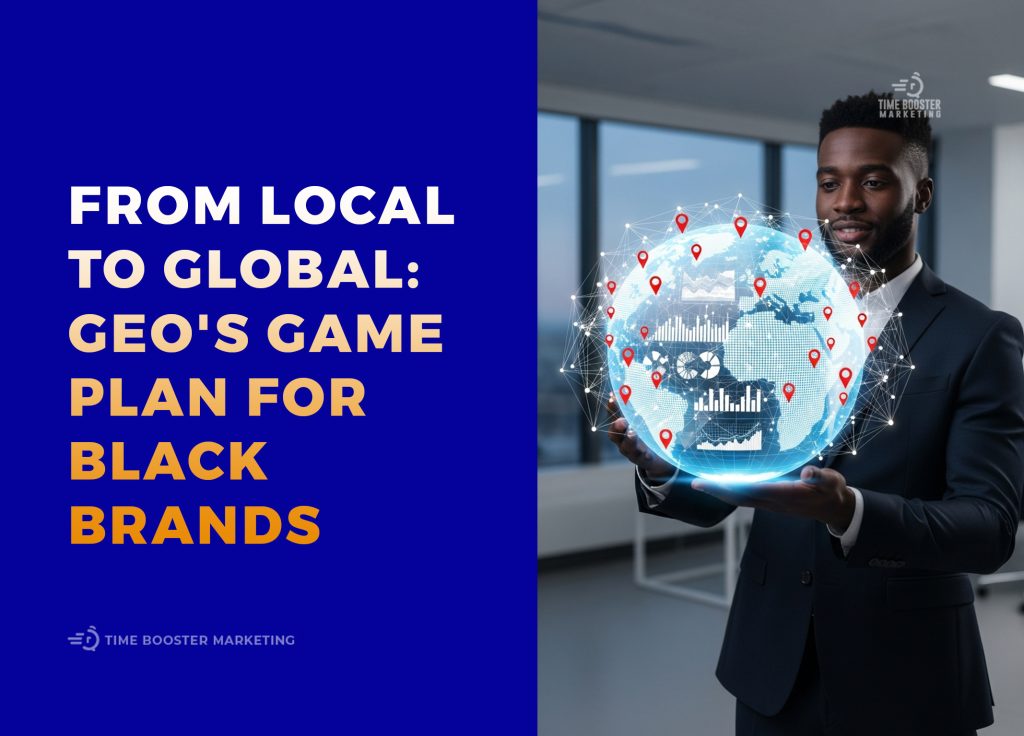How Black Brands Are Competing Using GEO
.png)
The digital marketing playbook for small businesses has been about trying to outspend or out-trick the competition. It was a game of chasing keywords, building links, and hoping to climb the ladder of Google’s search results, often feeling like you were on a treadmill going nowhere fast. Large corporations with their million-dollar budgets for ads and SEO teams always seemed to have the upper hand. But the way people find information online is fundamentally changing, and with it, the rules of the game are being rewritten. This change offers a remarkable opportunity for Black-owned brands to leapfrog the competition.
The new playing field is shaped by Generative Engine Optimization, or GEO. It’s a move away from just optimizing for a list of links and toward optimizing for the direct, conversational answers generated by AI like Google’s Search Generative Experience (SGE) or ChatGPT. When a user asks, “What are the best sustainable, Black-owned fashion brands?” the AI synthesizes information to provide a direct answer. GEO is the strategy of ensuring your brand is a key part of that answer.
This is more than just a new marketing buzzword; it’s a paradigm shift that favors authenticity over ad spend and expertise over sheer volume. It’s about proving your value, telling your story, and building trust in a way that AI can understand and amplify. For Black brands, many of which are built on deep passion, unique perspectives, and a strong sense of community, this is a golden opportunity. This guide will show you how competing using GEO is not just possible, but is a natural fit for the strengths you already possess.
1. What Is GEO?
Before we get into the “how,” it’s crucial to understand what GEO is and why it levels the playing field. Traditional SEO was often a technical battle. You found keywords, optimized your pages for them, and tried to get as many links as possible to signal to Google that your page was important. The brand with the most resources could often dominate this game.
GEO is different. It’s less about individual keywords and more about concepts, entities, and trustworthiness. An AI-powered search engine tries to understand the world in a way that is more like a human. It connects the dots between your brand, your founder, your products, and what the world is saying about you.
Think about the difference:
- Traditional SEO: The goal is to rank your webpage for the keyword “handmade soap.” You compete against thousands of other pages.
- Generative Engine Optimization (GEO): The goal is to have your brand featured in the AI-generated answer to the question, “Can you recommend a Black-owned brand that makes handmade soap with natural ingredients for sensitive skin?”
The second scenario is where smaller, niche brands can shine. The AI isn’t just looking for a keyword match; it’s looking for a brand that demonstrates experience, expertise, and a story that aligns with the user’s specific, nuanced request. It is looking for trust. This is the core of competing using GEO: you are not just optimizing a page, you are optimizing your entire brand’s reputation.
This shift is a huge advantage for Black brands because it values things that can’t be easily bought:
- Authenticity: A genuine brand story and mission.
- Expertise: Deep knowledge and passion for a specific niche.
- Community: A loyal following that provides social proof.
Big corporations often struggle with this. They can sound generic and corporate because they are. Your unique voice and story are now a top-tier marketing asset.
2. Your Story Is Your Greatest GEO Asset
Large companies spend billions trying to craft a relatable brand story. As a Black-owned business, you already have one. Your journey, your “why,” and your connection to your community are not just marketing angles; they are powerful data points that an AI engine uses to understand who you are.
Generative AI is designed to understand narrative. It analyzes content from across the web—your “About Us” page, articles about your brand, customer reviews, social media posts—to build a profile. A compelling and consistent narrative helps the AI classify you as a noteworthy and trustworthy entity. A strategy for competing using GEO must begin with your story.
How to Weave Your Narrative into Your GEO Strategy:
- Craft a “Cornerstone” About Us Page: This is perhaps the most important page on your website for GEO. It should be a detailed, comprehensive story.
-
- The Founder’s Journey: Who founded the brand and why? What personal experience or problem led to its creation? This humanizes the brand.
- The Mission and Values: What does your brand stand for beyond just selling products? Is it sustainability, community empowerment, celebrating culture? State it clearly.
. - The Milestones: Mention when your brand was founded, any awards you have won, or significant press mentions. This provides factual, entity-building information.
- Infuse Your Story into Product Descriptions: Don’t just list features. Tell the story behind the product. Why was this particular ingredient chosen? What cultural significance does this design have? For example, a skincare brand could explain the history of the African Black Soap it sources. This adds a layer of depth that a generic retailer cannot replicate.
- Share Behind-the-Scenes Content: Use your blog and social media to show the process. Videos of products being made, interviews with your team, or stories from your community all contribute to a rich, authentic narrative that AI can pull from.
When a user asks a question with a qualifier like “ethical,” “community-focused,” or “authentic,” a brand with a strong, well-documented narrative is far more likely to be included in the AI-generated answer.
3. Become the Expert With Niche Authority
Big companies often have to be generalists. They sell hundreds of different types of products to millions of people. This is their strength, but it’s also their weakness. As a smaller brand, your power lies in being a specialist. You can go deeper into a specific niche than a corporate giant ever could.
GEO is heavily influenced by the principles of E-E-A-T: Experience, Expertise, Authoritativeness, and Trustworthiness. AI wants to recommend sources that are genuinely knowledgeable. You can win by becoming the undisputed expert in your specific corner of the market. This focus on expertise is a non-negotiable part of competing using GEO.
Building and Demonstrating Your Niche Expertise:
- Create “Ultimate Guides”: Don’t just write a short blog post. Create the most comprehensive, helpful resource on the internet for a specific topic in your niche. If you sell wigs and extensions, write the definitive guide to “Caring for Protective Styles” or “Choosing the Right Lace Front for Beginners.” This cornerstone content establishes your authority.
- Answer Every Question: Use tools like AnswerThePublic or look at Google’s “People Also Ask” section to find every possible question your audience has about your niche. Create a massive FAQ page or a series of blog posts that answers these questions in detail. Each answer is a potential piece of an AI-generated summary.
- Host Webinars or Workshops: Go beyond written content. Hosting a live event where you share your expertise demonstrates a high level of confidence and authority. You can record these and post them on your site as valuable video content.
- Show, Don’t Just Tell: Use high-quality, original photos and videos. If you sell food products, show recipes being made. If you sell clothes, show how to style them for different occasions. This demonstrates real-world experience, the “E” in E-E-A-T.
A big box store can’t compete with the passion and detailed knowledge of a founder who has dedicated their life to perfecting a natural hair care formula. By generously sharing that knowledge, you signal to both users and AI that you are the expert.
4. Speaking the Language of AI: Long-Tail Keywords and Entities
The way people search is becoming more natural and conversational. Instead of typing “running shoes,” they might ask their phone, “What are the best running shoes for a beginner with flat feet?” These long, detailed questions are called long-tail keywords. Big companies often ignore these because the search volume for each one is low. But for a niche brand, this is a massive opportunity.
Your goal in competing using GEO is to create content that directly answers these specific, long-tail questions. When you do, you become the most relevant source for the AI to cite.
Optimizing for Conversational Search:
- Think in Questions: Structure your content around answering questions. Use headings that are literal questions (e.g., “How Do I Know if This Product is Right for My Skin Type?”).
- Focus on “Entity” Keywords: Don’t just focus on the product. Include related “entities” in your content. If you sell coffee, don’t just talk about “coffee beans.” Talk about the “Ethiopian Yirgacheffe region,” the “natural processing method,” the “notes of blueberry and jasmine,” and your “fair trade certification.” The AI connects these entities to understand that you have a deep, holistic knowledge of your product.
- Create Comparison Content: One of the most common types of conversational queries is comparisons. Create content that compares your product to alternatives. “Why Our Shea Butter is Different from Unrefined Shea Butter” or “Our Vegan Leather vs. Traditional Leather.” This positions you as a transparent and knowledgeable guide.
By focusing on these detailed, specific queries, you are not competing with a giant corporation for a broad keyword. You are winning a series of smaller, more qualified battles where your expertise gives you the clear advantage.
5. The Technical Side: Structured Data and Site Health
While GEO is less about technical tricks, a solid technical foundation is still essential. You need to make it as easy as possible for AI models to understand the information on your site. The most powerful tool for this is structured data, also known as schema markup.
Schema is a vocabulary of code that you add to your website to explicitly label your content for search engines. It’s like putting name tags on everything at a party so the host knows who everyone is.
Essential Schema for Competing Using GEO:
OrganizationSchema: On your homepage, this schema clearly identifies your brand name, logo, address, and social media profiles. It establishes you as a formal entity.ProductSchema: On your product pages, this identifies the product name, brand, price, reviews, and availability. This is crucial for e-commerce.PersonSchema: On your “About Us” page, use this for your founder to connect them officially to the brand.FAQPageSchema: If you have an FAQ page, this markup tells Google that the content is a series of questions and answers, making it easy to pull into a search result.ArticleorBlogPostingSchema: This identifies your blog posts, the author, and the publication date, which are all signals of credibility.
You don’t need to be a coder to implement this. Most modern e-commerce platforms and SEO plugins (like Yoast SEO or Rank Math for WordPress) can add much of this structured data for you. The key is to ensure it is set up correctly. A technically sound website is a prerequisite for a successful GEO strategy. This is a foundational aspect of competing using GEO that cannot be overlooked.
6. Your Community Is Your Loudspeaker
Big companies have to pay for focus groups and surveys to understand what their customers want. You have a direct line to a community that is often passionate and highly engaged. This community is not just a source of sales; it is a powerful engine for social proof that AI can measure.
Customer reviews, user-generated content (like customers posting photos with your products on Instagram), and testimonials are all powerful signals of trust and quality. An AI model can analyze the sentiment and volume of these mentions to determine how well-regarded your brand is.
Leveraging Your Community for GEO:
- Actively Encourage Reviews: After a purchase, send a follow-up email asking customers to leave a review, not just on your website but on your Google Business Profile as well.
- Create a Branded Hashtag: Encourage your customers to use a specific hashtag when they post about your products. This collects all your user-generated content in one place and creates a visible display of your community’s engagement.
- Showcase Testimonials Everywhere: Feature your best customer quotes and testimonials prominently on your homepage, product pages, and in your social media content.
Your loyal customers are your most effective marketers. By amplifying their voices, you are creating a chorus of positive sentiment that is impossible for AI engines to ignore.
Leveling the Playing Field
The shift toward a more intelligent, conversational, and trustworthy web is the best thing that has happened to small, mission-driven businesses in a long time. It signals a move away from a system that could be dominated by money and toward one that is won with authenticity, expertise, and a genuine connection with customers.
The strategy of competing using GEO allows Black-owned brands to lean into their inherent strengths. It’s a marathon, not a sprint. It requires a long-term commitment to creating high-quality, valuable content and building a brand that stands for something real. But by doing so, you are not just building a website that ranks; you are building a legacy brand that AI will recognize, respect, and recommend for years to come.





